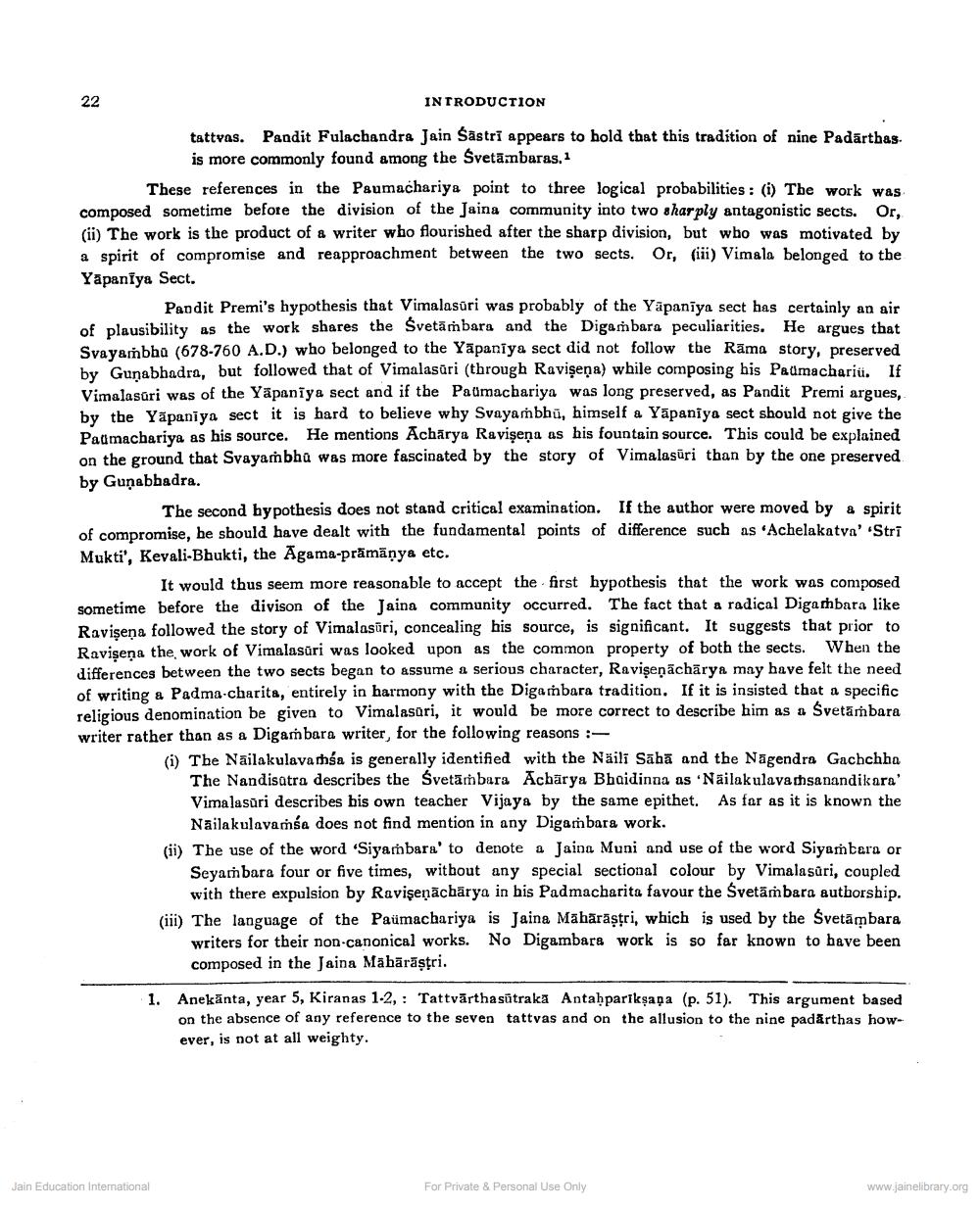________________
22
INTRODUCTION tattvas. Pandit Fulachandra Jain Śāstri appears to hold that this tradition of nine Padārthas.
is more commonly found among the Svetāmbaras,
These references in the Paumachariya point to three logical probabilities: (i) The work was composed sometime before the division of the Jaina community into two sharply antagonistic sects. Or, ci) The work is the product of a writer who flourished after the sharp division, but who was motivated by a spirit of compromise and reapproachment between the two sects. Or, (iii) Vimala belonged to the Yapaniya Sect.
Pandit Premi's hypothesis that Vimalasuri was probably of the Yapanīya sect has certainly an air of plausibility as the work shares the Svetāmbara and the Digambara peculiarities. He argues that Syayabha (678-760 A.D.) who belonged to the Yāpaniya sect did not follow the Rāma story, preserved by Gunabhadra, but followed that of Vimalasari (through Ravişeņa) while composing his Padmachariü. If Vimalasúri was of the Yāpaniya sect and if the Paümachariya was long preserved, as Pandit Premi argues, by the Yapaniya sect it is hard to believe why Svayambhū, himself a Yapaniya sect should not give the Padmachariya as his source. He mentions Achārya Ravişeņa as his fountain source. This could be explained on the ground that Svayambhu was more fascinated by the story of Vimalasuri than by the one preserved by Guņabbadra.
The second hypothesis does not stand critical examination. If the author were moved by a spirit of compromise, he should have dealt with the fundamental points of difference such as Achelakatya' Stri Mukti', Kevali-Bhukti, the Agama-prämänya etc.
It would thus seem more reasonable to accept the first hypothesis that the work was composed sometime before the divison of the Jaina community occurred. The fact that a radical Digambara like Ravisena followed the story of Vimalasūri, concealing his source, is significant. It suggests that prior to Ravisena the work of Vimalasări was looked upon as the common property of both the sects. When the differences between the two sects began to assume a serious character, Ravişenächärya may have felt the need of writing a Padma charita, entirely in harmony with the Digambara tradition. If it is insisted that a specific religious denomination be given to Vimalasari, it would be more correct to describe him as a Svetārbara writer rather than as a Digambara writer, for the following reasons :
(i) The Nailakulavamsa is generally identified with the Näili Sābā and the Nāgendra Gachchha
The Nandisutra describes the Svetambara Acharya Bhaidinna as 'Nailakulavathsanandikara' Vimalasari describes his own teacher Vijays by the same epithet. As far as it is known the
Nailakulavamsa does not find mention in any Digambara work. (ii) The use of the word 'Siyambara' to denote a Jaina Muni and use of the word Siyambara or
Seyambara four or five times, without any special sectional colour by Vimalasari, coupled
with there expulsion by Ravişenācārya in his Padmacharita favour the Svetāmbara authorship. (iii) The language of the Paümachariya is Jaina Mahārāştri, which is used by the Svetambara
writers for their non-canonical works. No Digambara work is so far known to have been composed in the Jaina Mabärāştri.
1. Anekānta, year 5, Kiranas 1-2,: Tattvārthasūtraka Antahpariksaņa (p. 51). This argument based
on the absence of any reference to the seven tattvas and on the allusion to the nine padārthas however, is not at all weighty.
Jain Education International
For Private & Personal Use Only
www.jainelibrary.org




